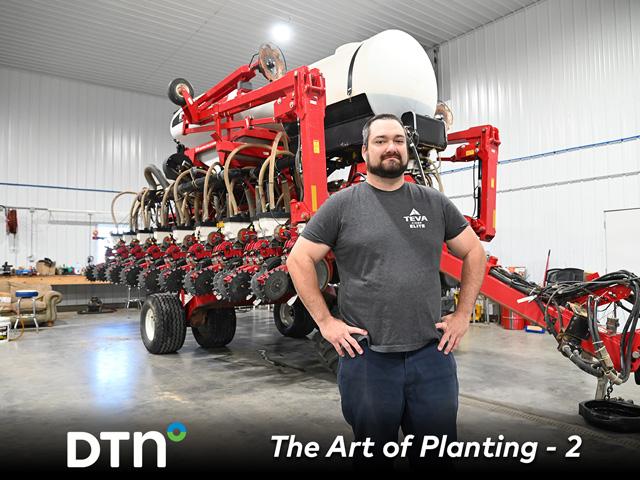The Art of Planting - 2
High-Yield Setup Maximizes Planter Performance
Editor's Note: It takes planning, proper maintenance and more to master the art of planting. DTN/Progressive Farmer's special series "The Art of Planting" is showcasing National Corn Yield Contest winners who consistently prepare their planters for the field to achieve winning yields and share their tips. This is the second of the stories; today corn-yield champ Ben Kron tells the top five planter components he focuses on, and he shares advice on how he does maintenance on them.
**
Corn-yield champ Ben Kron believes the best way to increase per-acre yields while keeping expenses in check is to maximize planter performance. "The planter is probably the most important part of raising high-yield corn. If it's not set right, your yield loss has already started," he stressed.
Kron's planter evaluation starts at harvest. From the combine seat, the Evansville, Indiana, farmer keeps a watchful eye on the yield monitor for unexpected drops in bushels per acre (bpa). At the same time, he looks for missing corn plants, uniform growth and plants that are too close together. All could indicate issues with seed meters, downforce, closing wheels and other planter components that can reduce yields.
"If a planter isn't set up and maintained properly, you can have every bit of a 20-bushel-per-acre difference in corn yield compared to one that is set up right," Kron explained. "That's 20 bushels that really doesn't cost you anything. It is all maintenance."
He uses a 16-row White 9831 planter for corn and soybeans. It's basically stock set up on 30-inch rows with a liquid fertilizer system. Nutrients are delivered in-furrow with a Keeton seed firmer. He recently sold a similar White planter that was only used for corn and will replace it with a near-new Case IH planter (he declined to reveal specifics since the deal hasn't been finalized) outfitted with Precision Planting components such as vDrive, vSet, SmartFirmer, DeltaForce and the Conceal liquid fertilizer delivery system.
Whether a planter is equipped with the latest aftermarket technology or factory components, Kron said higher yields can be achieved if a rigorous preseason maintenance and setup program is followed.
Kron won the National Corn Growers Association 2021 National Corn Yield Contest's strip-till, minimum-till, mulch-till, ridge-till irrigated class with nearly 391 bpa. He also broke the Indiana strip-till, irrigated corn-yield record that year.
The following are the top five planter components he focuses on to maximize yields.
SEED MATTERS
Kron meticulously checks every seed meter. His advice:
P[L1] D[0x0] M[300x250] OOP[F] ADUNIT[] T[]
-- Inspect all brushes for excessive wear. Ensure they are intact. Replace as needed.
-- Inspect all seed meter plates and make sure they move properly. Plates need to be even and not warped. Replace as needed.
-- Inspect chains for wear and play. Replace as needed.
Seed meters that aren't functioning properly increase the chances of skips and doubles when planting corn, which causes yield loss. "We spend a lot of time on seed meters in the winter," Kron said. "I do think electric drive and seed metering systems are the best, but properly maintained chain-driven systems can work great, as well."
OPENING DISCS
Proper seed depth and seed placement starts with the opening discs, Kron said. His advice:
-- Inspect the condition of all discs. Ensure they are consistent in size, and replace if necessary.
-- Make sure disc gaps are set appropriately.
-- Grease discs, and ensure they turn properly.
If opening discs are worn out or operating incorrectly, furrows could end up W-shaped instead of V-shaped, causing seed-depth variation. That can cause delayed or nonuniform emergence. "The opening discs create the trench that seeds lay in. If they aren't doing the job, yield is lost," Kron said.
DOWNFORCE
Both of Kron's planters in 2022 were equipped with factory spring downforce. Make sure springs are maintained and adjusted with the desired pressure to keep row units from bouncing and in contact with the ground. This ensures seed is planted at a consistent depth.
"Our older planter will have spring downforce, which means we must be a little more careful. Farmers can still use spring downforce and have good results," Kron said. "Our new planter will have hydraulic downforce, which will be nice."
CLOSING WHEELS
Closing the seed trench properly is important to prevent sidewall compaction and ensure proper seed-to-soil contact. If this doesn't occur, seed germination and uniform emergence are jeopardized.
Kron outfits his planters with Yetter 6200 Twister Poly closing wheels, which he believes boosts yield potential. "I feel the job they do is superior to all the other ones (aftermarket and factory closing wheels)," Kron explained. "They close the furrow properly without compacting, and the soil is loose enough, so seeds emerge more evenly."
A multilocation Beck's Superior Hybrids Practical Farm Research program study indicates Yetter Twister Poly closing wheels had a 5.1-bpa yield advantage in corn and a 2.5-bpa yield advantage in soybeans compared to two solid rubber closing wheels that come standard on most planters. The Yetter wheels also had a larger yield advantage for both crops compared to other aftermarket closing wheels tested.
LIQUID FERTILIZER
Applying liquid fertilizer at planting is a necessity to achieve high yields, Kron believes. He recommended farmers thoroughly check the system, including tanks, pumps and hoses, for leaks, corrosion or any problem that could hamper delivery of starter or liquid fertilizer.
"I think fertilizer on the planter is an absolute must," he said. "Nutrients are available to plants as soon as they come out of the ground to help them get a good start. It definitely improves yields."
To see stories that have already run in this series, go to:
The Art of Planting - 1 at https://www.dtnpf.com/…
(c) Copyright 2023 DTN, LLC. All rights reserved.






